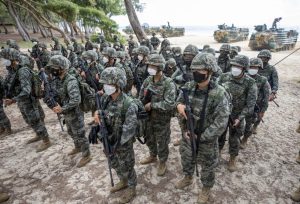In Eastern Europe, Russia’s bloody war against Ukraine grinds on in its fifth month. This ongoing conflict offers several vital lessons for the South Korea-U.S. alliance in its efforts to deter North Korea.
The first key lesson is a simple but critical insight based on Russia’s poor military performance throughout the war: quantitative superiority cannot compensate for shortcomings in logistics, training, leadership, and air support. On paper, the Russian Army massively outmanned and outgunned Ukraine’s forces. Despite this clear quantitative advantage, however, the Russian military has performed poorly throughout the war. It failed to seize Kyiv early in the war and has continued to struggle to secure the Donbas region, all while suffering catastrophic losses.
Analysts have attributed the Russian military’s failings to a wide range of critical shortcomings. The Russian Army has struggled to remain supplied with adequate munitions, food, and fuel, putting its units at a significant disadvantage. Russian forces have also proved poorly-trained and led, unable to conduct effective combined-arms warfare. Armored units have frequently deployed without adequate infantry support, for instance, rendering them vulnerable to anti-tank weaponry. Finally, the Russian military has been unable to secure command of the air over Ukraine, reducing its ability to employ airpower in support of its offensive.
Russia’s poor performance in offensive operations despite its quantitative superiority is a positive sign for South Korea-U.S. alliance given North Korea’s vast but qualitatively inferior Korean People’s Army (KPA). The KPA’s active duty personnel outnumber the Republic of Korea Army nearly two to one, with 950,000 active duty personnel opposing South Korea’s 550,000. Nevertheless, the KPA lacks the fuel, and transportation capabilities necessary to maintain a major offensive against South Korea. Even in peacetime, it suffers from chronic food shortages. The KPA is also poorly trained and lacks any recent combat experience. Finally, in any war against the allies, North Korea’s antiquated air force would likely prove easy pickings, denying the KPA any meaningful air support. Overall, this lesson bodes well for the allies; despite the intimidating size of the KPA, it would likely struggle far more than Russia has in a major offensive operation.
The second vital lesson that the allies can derive from this conflict stems from Russian decision-making in the lead up to its invasion: Closeted leaders may overestimate their ability to prevail in armed conflict. In hindsight, Russian President Vladimir Putin seems to have grossly exaggerated his prospects for victory in a Russia-Ukraine War. Many analysts have pointed out that Putin surrounded himself with political cronies and “yes men” inclined to report only positive estimates of Russian prospects. This may have contributed to Putin’s decision to launch what has proved to be a risky, overly-ambitious, and poorly-planned offensive.
The South Korea-U.S. alliance should pay heed to this development. Although there are many vital differences between Putin and North Korean despot Kim Jong Un, Kim has also reportedly centralized power and surrounded himself with devoted loyalists after numerous purges. This could very well skew Kim’s assessments of his country’s military capabilities and the KPA’s ability to prevail in a limited conflict. As such, the South Korea-U.S. alliance must work to ensure the continued strength and credibility of their combined deterrent.
A third and final lesson for the allies pertains to Russia’s nuclear saber-rattling: Nuclear weapons can play a significant role in deterring even limited outside intervention in a local conflict. Russia possesses one of the largest nuclear arsenals in the world and has deterred external intervention in the war in Ukraine by brandishing the threat of nuclear retaliation. The United States and its European allies have supplied Ukraine with significant armaments, but have refrained from becoming more directly involved. Even this indirect support has been constrained due to concerns about escalation; the U.S., for instance, balked at Polish plans to transfer MiG-29 fighter jets to Ukraine.
As North Korea enhances the survivability and versatility of its own nuclear arsenal, most recently pursuing tactical nuclear weapons, the South Korea-U.S. alliance will face a similar challenge. Although the U.S. is treaty-bound to contribute to the defense of South Korea, the prospect of North Korean nuclear retaliation would dramatically raise the cost of doing so. As such, Washington and Seoul must continue to bolster the credibility of the U.S. commitment to South Korean security to ensure that Pyongyang cannot drive a wedge between the allies in the event of a conflict.

































